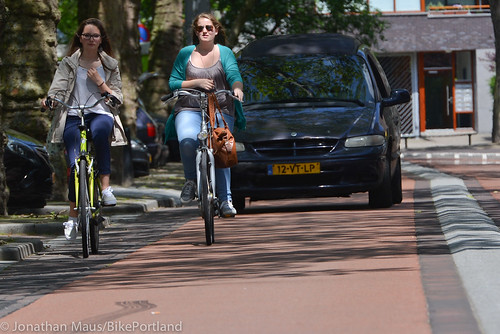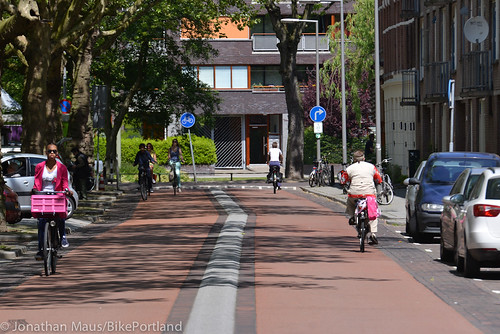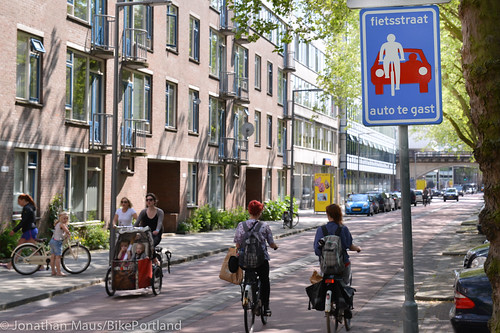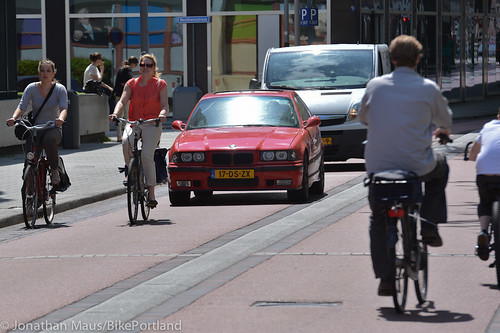
(Photos J. Maus/BikePortland)
Tonight in northeast Portland, the Bureau of Transportation will share their draft staff recommendation for the 20s Bikeway project. We’ll be there to see what their latest thinking is and — like everyone else — we’ll be especially interested to see what they have in mind for the segment of SE/NE 28th Avenue between Stark and Sandy. That’s the commercial district that has become the subject of a debate between auto parking and a dedicated bikeway.

In an interview with BikePortland last week, PBOT Director Leah Treat called the 20s Bikeway, “… probably one of the most controversial projects we’ve proposed in the last several years.”
But what if there was another way to approach the design? One that would improve the bicycling experience, while not leading to a major fight over parking? I’m thinking of something like the “bicycle street” design I saw in Rotterdam last summer. I’ve mentioned it in comments a few times, but I figured with PBOT getting closer to a design recommendation it’d be worth a bit more focus.
On Teilingerstraat in Rotterdam, people in cars behave as “guests” and people riding bikes position themselves in the middle of the lane without feeling threatened or stressed. Signs at the entrances to this particular segment of the street read: “Bike street: Cars are guests.” There are also design elements that accompany the sign: a red-colored roadway (standard for bikeways in Rotterdam) and a ramped curb center median. There was also a max speed of 18 mph.
Here’s a view via Google streetview:
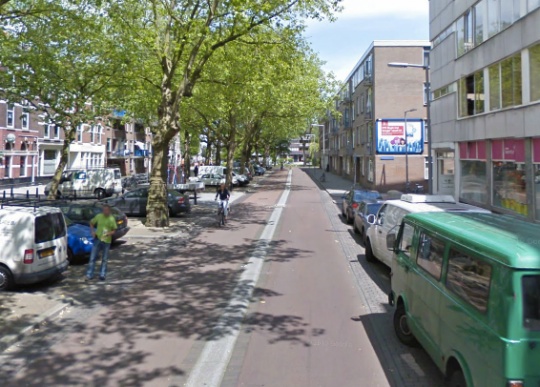
And a few more photos from my 2013 visit:
Similar to 28th between Stark and Sandy, this section of Teilingerstraat is a popular bikeway but it doesn’t have dedicated space for cycling. Instead, all road users simply share the space.
I was amazed at how this design worked. Drivers simply motored along at a courteous distance and speed while bicycle riders pedaled comfortably in front of them. Everyone understood the rules. I can’t help but wonder whether this type of design would work on 28th and other commercial district streets in Portland.
Of course, the design context in the Rotterdam street is much different. 28th Avenue has a much higher automobile traffic volume than Teilingerstraat. As pointed out to us by planner and regular commenter Nick Falbo back in February , “… that street in Rotterdam is not carrying 7,000 cars per day… the Rotterdam design would break down at 28th’s traffic levels.”
Nick is right. 7,000 average auto trips per day is well over twice the volume PBOT would feel comfortable with in designing for a shared environment (like they do on neighborhood greenways).
But I would counter his point by saying the the goal of road design in a dense business district should be just as much about quality of space as it is about volume and pace. In other words, what would be so bad about simply slowing people down? Isn’t it better for business to give people more time to see storefront signs and windows? And the slower speeds and traditional lane use in this design would make for a much safer and predictable walking environment.
Another issue with this design is that sharing the same space with auto users runs counter to the popular premise that the “interested but concerned” category of riders must have protected bike lanes.
From a PBOT engineering and planning standpoint, fear of trying this design on a busier street like 28th is that cars would back up and clog intersections, and many people might get frustrated with the slower speeds and opt for adjacent residential streets instead. I acknowledge that possibility; but I also know that by improving conditions for bicycling, the auto trip volume will eventually go down as more people make the switch.
At some point we have to stop being afraid of catering to existing behaviors to the detriment of our adopted planning goals and quality of life. This design is also appealing to me because it doesn’t carry the same “war on cars” political costs. Like many cities in the Netherlands have figured out, there’s no reason to be anti-car, you simply try to beat cars at their own game and everything will work itself out.
I’d love to hear what you think about this concept and whether or not it could ever work here in Portland.
(Stay tuned for a full report from tonight’s 20s Bikeway Stakeholder Advisory Committee meeting.)


